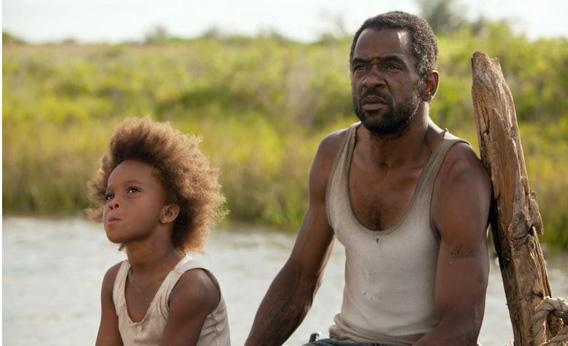Benh Zeitlin’s debut feature film Beasts of the Southern Wild is nothing if not original. This mythic tale about a coastal Louisiana community struggling to survive an environmental apocalypse is fierce, scruffy, passionate and proud: It sews its own freak flag out of reclaimed materials, then lets it fly. It’s hard not to admire Zeitlin’s ambitious vision, his do-it-yourself aesthetic, and the commitment of his cast and crew—a kind of utopian collective whose jobs often overlapped, as the local, nonprofessional actors collaborated on set-building and other technical tasks. But that doesn’t mean the result of their labor is exactly what you’d call a “good movie.”
Loosely based on the play Juicy and Delicious by the director’s childhood friend Lucy Alibar, who also collaborated with him on the screenplay, Beasts follows the displacements of a little girl, Hushpuppy (Quvenzhané Wallis) and her father, Wink (Dwight Henry) before, during, and after a natural disaster of increasingly massive proportions. Yes, Hushpuppy and Wink’s fictional hometown, a below-sea-level island known as the Bathtub, experiences a Katrina-like event, a hurricane followed by a levee-breaking flood. But there’s also a mass die-off of land animals for no clear reason. And in a sci-fi/fantasy subplot that’s the movie’s boldest gambit, a herd of aurochs—extinct prehistoric creatures that, in Zeitlin’s vision, become flesh-eating wild boars the size of buses—thaws out in the melting polar icecaps and comes back to life.
Amid all this chaos, 6-year-old Hushpuppy and her father must unite their scattered but loyal fellow Bathtubbers in a joint project of bare-bones survival. They build a floating shelter out of flood debris, stocking it with chickens, goats, and potted vegetables. During the day Hushpuppy and her dad set out on separate fishing expeditions in their own boat, fashioned from a severed pickup-truck bed mounted on barrels. At one point, Wink hatches an ill-planned attempt to blow up a levee in order to drain a flooded patch of land; later, Hushpuppy and three other children swim out to a floating brothel to eat deep-fried gator and dance with prostitutes. There are multiple scenes of drunken crab-shelling parties that seem to have been filmed during actual drunken crab-shelling parties.
All the while, Zeitlin is at pains to remind us that the Bathtub people are courageous, life-loving survivors, despite (or, it’s sometimes suggested, because of) heavy drinking and family dysfunction. Dwight Henry—a New Orleans baker who was cast as the father after Zeitlin’s crew started buying breakfast at his shop—gives a movingly raw performance as the troubled Wink. But rather than complexly self-contradictory, the character as written often seems half-baked. Early in the film, Wink is shown treating his daughter with alternating savagery and neglect—behaviors that were hard for me to square with later scenes, when he’s painted as a devoted, self-sacrificing father.
After the terrible things Wink lets happen to his daughter during the opening scenes, it would take a really well-written second half to make us believe in his moral transformation—and this movie’s second half is barely written at all.
Beasts of the Southern Wild isn’t long on story structure, character motivation, or pacing–it has a tendency to lurch from one emotional high point to the next, aided by a constant stream of bayou-inflected music (some of it co-composed by the director, much of it quite lovely, but enough already with the music) and a relentless voice-over from the precociously poetic Hushpuppy (“When all goes quiet behind my eyes, I see everything that made me flying around in invisible pieces.” “Me and my daddy, we stay right here. We who this earth is for.”) Quvenzhané Wallis, only 6 at the time of filming (and 5 when she was first cast) is a remarkably beautiful and self-possessed child, with a serious, thoughtful face that holds the screen all by itself—she didn’t need to be saddled with lyrical logorrhea to make us root for her survival.
Though Beasts of the Southern Wild strikes me as a far sight too taken with itself, I can understand the reasons for the film’s popularity with festival audiences, and with many critics as well. Twenty-nine-year-old Zeitlin is a visually gifted director with an inspiring working process, and the Louisiana bayou is a rich and mysterious place in which to set a modern-day folk legend. (Also, the aurochs—who were created on the cheap by dressing pigs up in furry, be-tusked costumes and filming them with clever tricks of scale—are living, snuffling examples of how imaginative low-tech special effects can be.) But the director’s idealized portrait of his beloved Bathtub stalwarts rang a false note for me. We’re meant to admire these people’s indomitable high spirits as they stomp around their squalorous lean-tos offering tumblers of liquor to 6-year-olds, but Zeitlin’s adoring gaze on the Bathtubbers’ chaotic-yet-joyous way of life smacks of anthropological voyeurism: Rousseau’s “noble savage” nonsense all over again, but with crawdads and zydeco.
